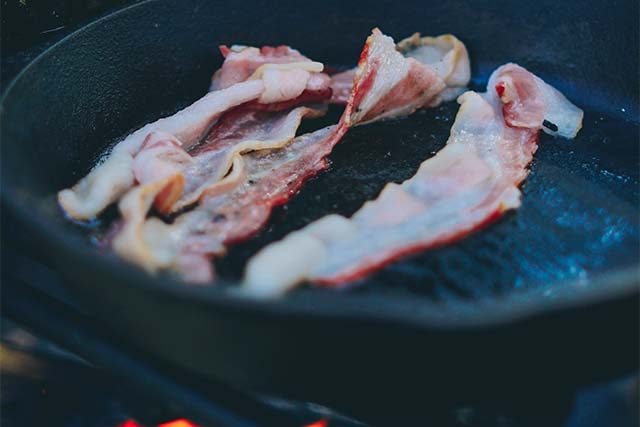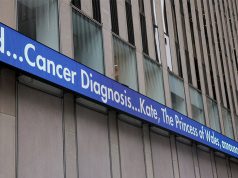Bacon is a much-loved, comforting breakfast item – during the global pandemic, sales have surged in the US and the UK. But while bacon may be delicious, experts recommend people eat little or no processed meats because of their cancer risk. But while the cancer risk from processed foods is certainly something to think about, that doesn’t mean bacon should be totally off the menu. In fact, you might be able to lower some of the cancer risk from eating bacon depending on how you cook it.
Nitrites are perhaps the best-known cancer risk in bacon. Nitrites are used as a preservative, and are also converted in the stomach into N-nitroso compounds (NOCs), which can cause cancer.
Some bacon products are now advertised as “nitrite-free”. However, some of these products merely replace synthetic nitrite with a vegetable source, which is still converted into NOCs. These carcinogens also form when bacon is fried. Some processed meats don’t contain nitrites and aren’t cooked (such as parma ham), so they carry a lower cancer risk compared to bacon.
But avoiding nitrites will not eliminate all cancer risks from bacon. This is because frying also generates two other major groups of carcinogens. One of these is a group called heterocyclic amines (HCAs). Fried bacon contains more HCAs than any other cooked meat, and high levels of advanced glycation end products (AGEs) which are also linked to cancer.
Both HCAs and AGEs are produced by a chemical process called the Maillard reaction, which increases rapidly with heat. So your cancer risk could depend on how you cook your bacon. For instance, lightly browned bacon has only one-tenth the HCAs of well-cooked bacon. The Maillard reaction causes browning (thus producing carcinogens), so cooking methods where there’s little browning also usually result in fewer HCAs and AGEs. Hence microwaved bacon has far lower levels of AGEs than fried bacon.
Grilling/broiling bacon under a direct flame may also be unwise, as close contact with a naked flame generates very high temperatures that also cause drying on the surface of the bacon. Both of these factors increase HCA formation.
As flavour comes with frying, many bacon lovers will probably baulk at the idea of only lightly fried bacon. Fortunately, it may be possible to reduce carcinogen production without compromising taste. This is because flavour molecules are produced by a different part of the Maillard reaction to that generating HCAs and AGEs.
Foods rich in antioxidants are able to reduce harmful oxidizing chemical reactions. This may suppress the part of the Maillard reaction that leads to HCAs and AGEs. Frying with a cooking oil rich in antioxidants – such as extra virgin olive oil – may lower cancer risk compared to frying in other cooking oils which are much lower in antioxidants.
Oesophageal cancer
However, some groups may be at higher risk compared to others from the cancer-causing carcinogens in bacon.
Research has found a strong association between eating processed meat and an increased risk of oesophageal cancer called oesophageal adenocarcinoma. The UK has the highest incidence in the world of this deadly type of cancer.
The main pre-cancerous state for oesophageal adenocarcinoma is a condition called Barrett’s oesophagus. About 1 million people in the UK have Barrett’s oesophagus and around 3-13% of these people will go on to develop oesophageal adenocarcinoma – an eleven-fold greater risk than the general population.
So people with Barrett’s oesophagus should be particularly wary of eating bacon. The link between oesophageal adenocarcinoma and bacon is inflammation, with compelling evidence showing inflammation drives Barrett’s oesophagus to cancer. For instance, people with an inflamed oesophagus (oesophagitis) have a four-fold increased risk of oesophageal adenocarcinoma compared with the general population. And for those already with Barrett’s oesophagus, oesophagitis increases the risk of developing oesophageal adenocarcinoma thirty-fold.
Diets high in inflammatory foods are associated with an increased risk of oesophageal adenocarcinoma. As AGEs found in bacon are potent inflammatory molecules linked to increased cancer risk, the exceptionally high levels of AGEs in bacon may pose a particular risk for oesophageal inflammation and oesophageal adenocarcinoma. However, no research has yet tested whether the inflammatory compounds in fried bacon make it more of a cancer risk than other processed meat.
Due to this lack of research, current UK guidelines for the management of Barrett’s oesophagus make no mention of diet. But given what we know more generally about the carcinogens in bacon causing cancer, it’s best to remain cautious.
Worryingly, only about 10% of people with Barrett’s oesophagus know they have it. The majority of people with undetected Barrett’s oesophagus will have developed it as a result of chronic acid reflux. So bacon lovers who are prone to acid reflux may want to avoid bacon while they seek out treatment.
Either way, a few simple steps can help lower cancer risk – such as gently frying bacon on a low heat, using extra virgin olive oil, or lower oven or grill temperatures and switching to non-fried, nitrite-free processed meats. Eating a healthy diet – such as the Mediterranean diet, which is particularly effective at lowering inflammation in the body – may also help reduce overall risk.![]()
Richard Hoffman, Associate lecturer, University of Hertfordshire. This article is republished from The Conversation under a Creative Commons license. Read the original article.










